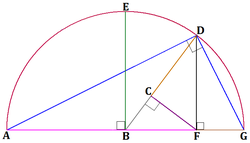Medians in a circle
 In the diagram, let
and
. Then, choose the answer that represents correctly the arithmetic, geometric and harmonic mean of
and
, respectively.
In the diagram, let
and
. Then, choose the answer that represents correctly the arithmetic, geometric and harmonic mean of
and
, respectively.
This section requires Javascript.
You are seeing this because something didn't load right. We suggest you, (a) try
refreshing the page, (b) enabling javascript if it is disabled on your browser and,
finally, (c)
loading the
non-javascript version of this page
. We're sorry about the hassle.
r=(m+n)/2 AM=(m+n)/2=r=BE GM=(mn)^(1/2). Now, BF=(m-n)/2. Using pythagoras in triangle BDF, we get DF^2=BD^2 - BF^2=m n. Therefore, DF=sq rt of (m n). Hence, the answer is option 2.